Data Link with a High-Power Pulsed Quantum Cascade Laser Operating at the Wavelength of 4.5 µm
Abstract
1. Introduction
2. Materials and Methods
2.1. Analysis of the OWC System
2.2. Link Budget
3. Results
3.1. QC Laser Research for OWC Application
3.2. Transmitter with Pulsed QC Laser
4. Conclusions
Funding
Institutional Review Board Statement
Informed Consent Statement
Data Availability Statement
Acknowledgments
Conflicts of Interest
References
- Pirotta, S.; Tran, N.-L.; Jollivet, A.; Biasiol, G.; Crozat, P.; Manceau, J.-M.; Bousseksou, A.; Colombelli, R. Fast amplitude modulation up to 1.5 GHz of mid-IR free-space beams at room-temperature. Nat. Commun. 2021, 12, 799. [Google Scholar] [CrossRef] [PubMed]
- Mottaghizadeh, A.; Asghari, Z.; Amanti, M.; Gacemi, D.; Vasanelli, A.; Sirtori, C. Ultra-Fast modulation of mid infrared buried heterostructure quantum cascade lasers. In Proceedings of the 2017 42nd International Conference on Infrared, Millimeter, and Terahertz Waves (IRMMW-THz), Cancun, Mexico, 27 August–1 September 2017; pp. 1–2. [Google Scholar]
- Calvar, A.; Amanti, M.I.; Renaudat St-Jean, M.; Barbieri, S.; Bismuto, A.; Gini, E.; Beck, M.; Faist, J.; Sirtori, C. High frequency modulation of mid-infrared quantum cascade lasers embedded into microstrip line. Appl. Phys. Lett. 2013, 102, 181114. [Google Scholar] [CrossRef]
- Mikołajczyk, J.; Szabra, D.; Prokopiuk, A.; Achtenberg, K.; Wojtas, J.; Bielecki, Z. Optical wireless communications operated at long-wave infrared radiation. Int. J. Electron. Telecommun. 2020, 66, 383–387. [Google Scholar]
- Rogalski, A. Competitive technologies of third generation of infrared photon detectors. Opto-Electron. Rev. 2006, 14, 87–101. [Google Scholar] [CrossRef]
- Rogalski, A.; Martyniuk, P.; Kopytko, M.; Madejczyk, P.; Krishna, S. In AsSb-Based Infrared Photodetectors: Thirty Years Later Onby. Sensors 2020, 20, 47. [Google Scholar] [CrossRef]
- Downs, C.; Vandervelde, T.E. Progress in Infrared Photodetectors Since 2000. Sensors 2013, 13, 5054. [Google Scholar] [CrossRef]
- Chen, B.; Chen, Y.; Deng, Z. Recent Advances in High Speed Photodetectors for eSWIR/MWIR/LWIR Applications. Photonics 2021, 8, 14. [Google Scholar] [CrossRef]
- Martyniuk, P.; Kożniewski, A.; Kębłowski, A.; Gawron, W.; Rogalski, A. MOCVD grown MWIR HgCdTe detectors for high operation temperature conditions. Opto-Electron. Rev. 2014, 22, 118–126. [Google Scholar] [CrossRef]
- Besikci, C. High-x InP/InxGa1−xAs quantum well infrared photodetector. Quantum Electron. 2006, 95, 152–157. [Google Scholar] [CrossRef]
- Oogarah, T.; Liu, Z.H.C.; Dupont, E.; Wasilewski, Z.R.; Byloos, M.; Buchanan, M. High absorption GaAs/AlGaAs quantum well infrared photodetectors. Semicond. Sci. Technol. 2012, 17, L41. [Google Scholar] [CrossRef]
- Wu, D.; Li, J.; Dehzangi, A.; Razeghia, M. Mid-wavelength infrared high operating temperature pBn photodetectors based on type-II InAs/InAsSb superlattice. AIP Adv. 2020, 10, 025018. [Google Scholar] [CrossRef]
- Plis, E.; Lee, S.J.; Zhu, Z.; Amtout, A.; Krishna, S. InAs/GaSb superlattice detectors operating at room temperature. IEEE J. Sel. Top. Quantum Electron. 2006, 12, 1269–1274. [Google Scholar] [CrossRef]
- Rogalski, A. Quantum well photoconductors in infrared detector technology. J. Appl. Phys. 2003, 93, 4355. [Google Scholar] [CrossRef]
- Pusz, W.; Kowalewski, A.; Gawron, W.; Plis, E.; Krishna, S.; Rogalski, A. MWIR type-II InAs/GaSb superlattice interband cascade photodetectors. In Proceedings of the Infrared Sensors, Devices, and Applications III, San Diego, CA, USA, 25–29 August 2013; Volume 8868. [Google Scholar] [CrossRef]
- Rogalski, A.; Kopytko, M.; Martyniuk, P.; Hub, W. Comparison of performance limits of HOT HgCdTe photodiodes with 2D material infrared photodetectors. Opto-Electron. Rev. 2020, 28, 82–92. [Google Scholar]
- Martini, R.; Whittaker, E.A. Quantum Cascade Laser-Based Free Space Optical Communications. In Free-Space Laser Communications; Springer: New York, NY, USA, 2005; pp. 393–406. [Google Scholar]
- Pang, X.; Ozolins, O.; Zhang, L.; Schatz, R.; Udalcovs, A.; Yu, X.; Jacobsen, G.; Popov, S.; Chen, J.; Lourdudoss, S. Free-Space Communications Enabled by Quantum Cascade Lasers. Phys. Status Solidi. 2021, 218, 2000407. [Google Scholar] [CrossRef]
- Liu, C.; Zhai, S.; Zhang, J.; Zhou, Y.; Jia, Z.; Liu, F.; Wang, Z. Free-space communication based on quantum cascade laser. J. Semicond. 2015, 36, 9. [Google Scholar] [CrossRef]
- Johnson, S.; Dial, E.; Razeghi, M. High-speed free-space optical communications based on quantum cascade lasers and type-II superlattice detectors. In Proceedings of the Quantum Sensing and Nano Electronics and Photonics XVII, San Francisco, CA, USA, 1–6 February 2020; Razeghi, M., Lewis, J.S., Khodaparast, G.A., Khalili, P., Eds.; SPIE: Washington, DC, USA, 2020; p. 1128814. [Google Scholar]
- Maulini, R.; Lyakh, A.; Tsekoun, A.G.; Go, R.; Lane, M.; Macdonald, T.; Patel, C.K.N. High Power, High Efficiency Quantum Cascade Laser Systems for Directional Infrared Countermeasures and other Defense and Security Applications; Titterton, D.H., Richardson, M.A., Eds.; SPIE: Washington, DC, USA, 2009; p. 74830D. [Google Scholar]
- Zhou, W.; Wu, D.; Lu, Q.-Y.; Slivken, S.; Razeghi, M. Single-mode, high-power, mid-infrared, quantum cascade laser phased arrays. Sci. Rep. 2018, 8, 14866. [Google Scholar] [CrossRef]
- Gökden, B.; Bai, Y.; Bandyopadhyay, N.; Slivken, S.; Razeghi, M. Broad area photonic crystal distributed feedback quantum cascade lasers emitting 34 W at λ∼4. 36 μm. Appl. Phys. Lett. 2010, 97, 131112. [Google Scholar] [CrossRef]
- Rauter, P.; Menzel, S.; Goyal, A.K.; Wang, C.A.; Sanchez, A.; Turner, G.; Capasso, F. High-power arrays of quantum cascade laser master-oscillator power-amplifiers. Opt. Express 2013, 21, 4518. [Google Scholar] [CrossRef]
- Paranalytica Pranalytica High Power Laser System Model 1101-46-CW-XXXX. Available online: http://www.pranalytica.com (accessed on 6 May 2021).
- Mikołajczyk, J.; Bielecki, Z.; Bugajski, M.; Piotrowski, J.; Wojtas, J.; Gawron, W.; Szabra, D.; Prokopiuk, A. Analyses of Free Space Optics development. Metrol. Meas. Syst. 2017, 24, 653–674. [Google Scholar] [CrossRef]
- Nebulon, R. Empirical relationships between extinction coefficient and visibility in fog. Appl. Optics 2005, 44, 18. [Google Scholar] [CrossRef] [PubMed]
- Singhal, P.; Gupta, P.; Rana, P. Basic Concept of Free Space Optics Communication (FSO): An Overview. In Proceedings of the 2015 International conference on communications and signal processing (ICCSP), Melmaruvathur, India, 2–4 April; pp. 439–442. [CrossRef]
- Nor, N.A.M.; Rafiqul, I.M.; Al-Khateeb, W.; Zabidi, S.A. Environmental effects on free space earth-to-satellite optical link based on measurement data in Malaysia. In Proceedings of the 2012 International Conference on Computer and Communication Engineering (ICCCE), Kuala Lumpur, Malaysia, 3–5 July 2012; pp. 694–699. [Google Scholar]
- Nadeem, F.; Flecker, B.; Leitgeb, E.; Khan, M.S.; Awan, M.S.; Javornik, T. Comparing the fog effects on hybrid network using Optical Wireless and GHz links. In Proceedings of the Proceedings of the 6th International Symposium Communication Systems, Networks and Digital Signal Processing, CSNDSP 08, Graz, Austria, 25 July 2008. [Google Scholar]
- Pérez-Díaz, J.; Ivanov, O.; Peshev, Z.; Álvarez-Valenzuela, M.; Valiente-Blanco, I.; Evgenieva, T.; Dreischuh, T.; Gueorguiev, O.; Todorov, P.; Vaseashta, A. Fogs: Physical basis, characteristic properties, and impacts on the environment and human health. Water 2017, 9, 807. [Google Scholar] [CrossRef]
- Fadhil, H.A.; Amphawan, A.; Shamsuddin, H.A.B.; Hussein Abd, T.; Al-Khafaji, H.M.R.; Aljunid, S.A.; Ahmed, N. Optimization of free space optics parameters: An optimum solution for bad weather conditions. Optik (Stuttg). 2013, 124, 3969–3973. [Google Scholar] [CrossRef]
- Murty, S.S.R. Laser beam propagation in atmospheric turbulence. Proc. Indian Acad. Sci. 1979, C2, 179–195. [Google Scholar]
- Xu, G.; Xuping Zhang, X.; Wei, J.; Fu, X. Influence of Atmospheric Turbulence on FSO Link Performance; SPIE: Washington, DC, USA, 2004; pp. 816–823. [Google Scholar]
- Bai, F.; Su, Y.; Sato, T. Performance Analysis of Polarization Modulated Direct Detection Optical CDMA Systems over Turbulent FSO Links Modeled by the Gamma-Gamma Distribution. Photonics 2015, 2, 139–155. [Google Scholar] [CrossRef]
- Charnotskii, M.; Baker, G.J. Practical Calculation of the Beam Scintillation Index Based on the Rigorous Asymptotic Propagation Theory; Wasiczko Thomas, L.M., Spillar, E.J., Eds.; SPIE: Washington, DC, USA, 2011; p. 803804. [Google Scholar]
- Lee, I.E.; Ghassemlooy, Z.; Ng, W.P.; Uysal, M. Performance Analysis of Free Space Optical Links over Turbulence and Misalignment Induced Fading Channels. IET Int. Sym. on Comm. Syst. Net. Dig. Sig. Proc. 2012. [Google Scholar] [CrossRef]
- Kalinowski, P.; Mikołajczyk, J.; Piotrowski, A.; Piotrowski, J. Recent advances in manufacturing of miniaturized uncooled IR detection modules. Semicond. Sci. Technol. 2019, 34, 033002. [Google Scholar] [CrossRef]
- VIGO System S.A. Medium Size Preamp. Available online: https://vigo.com.pl/wp-content/uploads/2017/06/MIP-Datasheet.pdf (accessed on 6 May 2021).
- Gawron, W.; Kalinowski, P.; Fimiarz, M.; Mikołajczyk, J.; Wojtas, J. Detection Modules for FSO Receiver Operating in the Wavelength Range of 8–12 μm; SPIE: Washington, DC, USA, 2017; p. 1043709. [Google Scholar]
- Wolfe, W.L.; Zissis, G.J. The infrared handbook; Environmental Research Institute of Michigan; The Office of Naval Research: Washington, DC, USA, 1978. [Google Scholar]
- Andrews, L.C. Field Guide to Atmospheric Optics; SPIE: Washington, DC, USA, 2004. [Google Scholar]

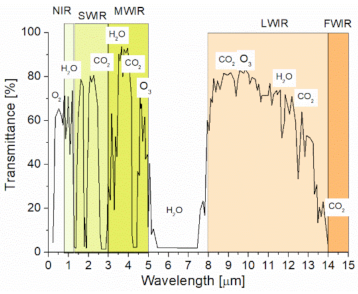




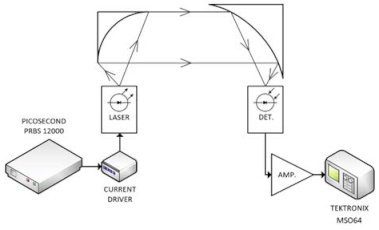
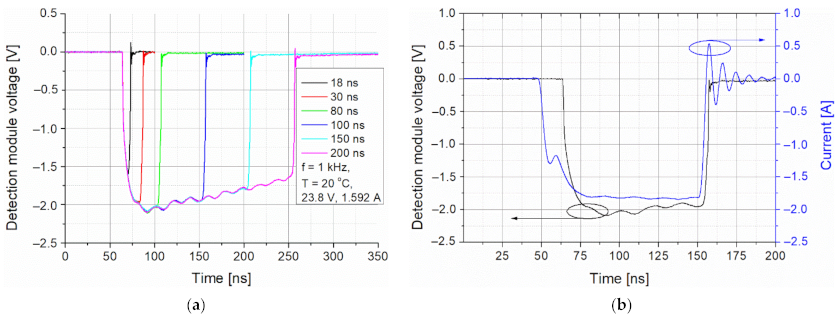

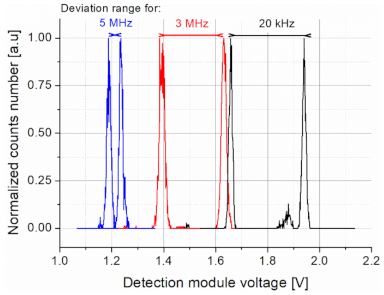

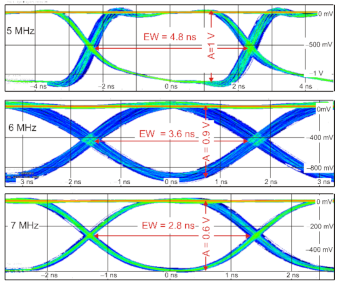
| MCT | QWIP | SLS | |
|---|---|---|---|
| Technological status | advanced | commercial | research |
| Quantum Efficiency | high | low | medium |
| Spectral range | wide | narrow | wide |
| Detectivity [cmHz1/2/W] (Temperature) | 8.7 × 1010 (300 K) [9] | 1 × 1011 (78 K) [10] 2 × 108 (210 K) [11] | 7.1 × 1011 (150 K) [12] 4.6 × 109 (300 K) [13] |
| Response time | from tens/hundreds of ps up to a few ns [8] | a few ps [14] | a few ns [15] |
| Group | Wavelength [µm] | Modulation | Power/ Current | Mode Type | Sensor | Lit. |
|---|---|---|---|---|---|---|
| A | 8 | 2.5 Gb/s | 10 mW (0.3 + ?) A | Bias-T (cw OWC) | MCT | [17] |
| 9.7 | Analog 1.5 GHz | 10 mW 0.02 A | RF injection (cw) | MCT | [1] | |
| 4.65 | Analog 23 MHz PAM-4 4 GB/s | 60 mW (0.18 + 0.35) A | Bias-T (cw OWC) | MCT | [18] | |
| 4.7 | Analog 30 MHz | 12 mW (0.35 + 0.1) A | Bias-T (cw OWC) | MCT | [19] | |
| 4.8 | Analog 10 MHz | 200 mW (0.65 + 0.4) A | Bias-T (cw OWC) | T2SL | [20] | |
| 4.6 | Analog 1 MHz | 2.2 W 1.5 A | Pulsed (76%) | ? | [21] | |
| B | 4.8 | Analog 50 kHz | 20 W | QCL-PA | MCT | [22] |
| 4.36 | Analog 20 kHz | 40 W | QCL-PCDF | InSb | [23] | |
| 9.2–9.8 | Analog 10 kHz | 2 ÷ 10 W | QCL-MOPA | MCT | [24] | |
| C | 9.35 | Analog 4 MHz | 300 mW | Pulsed | MCT | [4] |
| Wavelength [µm] | Attenuation [1/km] | ||
|---|---|---|---|
| RH = 50% | RH = 70% | RH = 100% | |
| 1.5 | 0.014 | 0.02 | 0.028 |
| 4.5 | 1.23 | 1.31 | 1.42 |
| Parameter | Value | Spectral Characteristics |
|---|---|---|
| Active area | 1 × 1 mm2 | 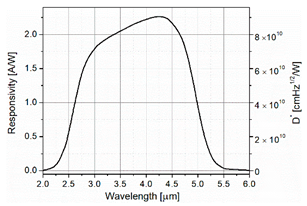 |
| Detector resistance | 60 kΩ | |
| Current noise density | 2.4 pA/√Hz | |
| Responsivity | 2.25 A/W | |
| Detectivity D* | 9 × 1010 cm√Hz/W |
Publisher’s Note: MDPI stays neutral with regard to jurisdictional claims in published maps and institutional affiliations. |
© 2021 by the author. Licensee MDPI, Basel, Switzerland. This article is an open access article distributed under the terms and conditions of the Creative Commons Attribution (CC BY) license (https://creativecommons.org/licenses/by/4.0/).
Share and Cite
Mikołajczyk, J. Data Link with a High-Power Pulsed Quantum Cascade Laser Operating at the Wavelength of 4.5 µm. Sensors 2021, 21, 3231. https://doi.org/10.3390/s21093231
Mikołajczyk J. Data Link with a High-Power Pulsed Quantum Cascade Laser Operating at the Wavelength of 4.5 µm. Sensors. 2021; 21(9):3231. https://doi.org/10.3390/s21093231
Chicago/Turabian StyleMikołajczyk, Janusz. 2021. "Data Link with a High-Power Pulsed Quantum Cascade Laser Operating at the Wavelength of 4.5 µm" Sensors 21, no. 9: 3231. https://doi.org/10.3390/s21093231
APA StyleMikołajczyk, J. (2021). Data Link with a High-Power Pulsed Quantum Cascade Laser Operating at the Wavelength of 4.5 µm. Sensors, 21(9), 3231. https://doi.org/10.3390/s21093231






